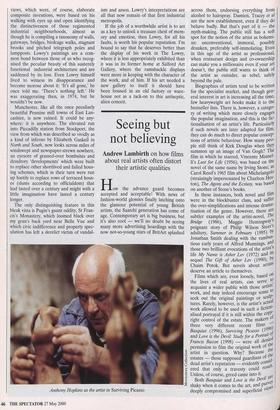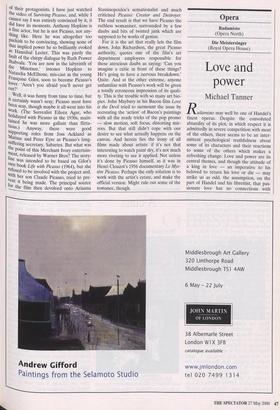Seeing but not believing
Andrew Lambirth on how films about real artists often distort their artistic qualities How the advance guard becomes accepted and acceptable! With news of fashion-world glossies finally latching onto the glamour potential of young British artists, the Saatchi generation has come of age. Contemporary art is big business, but it's also cool — we'll no doubt be seeing many more advertising hoardings with the now not-so-young stars of BritArt splashed across them, endorsing everything from alcohol to hairspray. Damien, Tracey et al are the new establishment, even if they do behave badly. But that's part of it — the myth-making. The public still has a soft spot for the notion of the artist as bohemi- an: unconventional, immoral, possibly drunken, preferably self-immolating. Even in this age of the artist as professional, when restaurant design and co-ownership can make you a millionaire even if your art doesn't, the public still wants to think of the artist as outsider, as rebel, safely beyond the pale.
Biographies of artists tend to be written for the specialist market, and though gen- eral interest in art is increasing all the time, few heavyweight art books make it to the bestseller lists. There is, however, a catego- ry of writing which more closely engages the popular imagination, and this is the fic- tionalisation of an artist's life. Particularly if such novels are later adapted for film, they can do much to direct popular concep- tions of artistic behaviour. How many peo- ple still think of Kirk Douglas when they summon up an image of Van Gogh? The film in which he starred, Vincente Minnel- li's Lust for Life (1956), was based on the novel of the same name by Irving Stone; as Carol Reed's 1965 film about Michelangelo (strainingly impersonated by Charlton Hes- ton), The Agony and the Ecstasy, was based on another of Stone's books.
In these instances, both novel and film were in the blockbuster class, and suffer the over-simplifications and intense drama- tisation of the genre. However, there are subtler examples of the artist-novel, The Bridge (1986), Maggie HemingwaY,s poignant story of Philip Wilson Steer s adultery, Summer in February (1995) by Jonathan Smith dealing with the rumbus- tious early years of Alfred Munnings, and those two brilliant evocations of the artist s life My Name is Asher Lev (1972) and las sequel The Gift of Asher Lev (1990), by Chaim Potok. But novels about artists deserve an article to themselves.
Films which are, even loosely, based 00 the lives of real artists, can serve t°, acquaint a wider public with those artists work, and may indeed encourage some t° seek out the original paintings or sculp- tures. Rarely, however, is the artist's actual work allowed to be used in such a fiction- alised portrayal if it is still within the eoPY; right control of the estate. The makers 0` three very different recent films Basquiat (1996), Surviving Picasso (1990) and Love is the Devil: Study for a Portrait of Francis Bacon (1998) — were all denied permission to film the original work of the artist in question. Why? Because the estates — those supposed guardians of the dead artist's reputation — evidently consl t ered that only a travesty could result. Unless of course, greed came into it. Both Basquiat and Love is the Devil are shaky when it comes to the art, and poll: ..eYs deeply compromised and superficial vicv" of their protagonists. I have just watched the video of Surviving Picasso, and, while I cannot say I was entirely convinced by it, it did have its moments. Anthony Hopkins is a fine actor, but he is not Picasso, nor any- thing like. Here he was altogether too puckish to be convincing, showing none of that implied power he so brilliantly evoked as Hannibal Lecter. This was partly the fault of the chirpy dialogue by Ruth Prawer Jhabvala. 'You are now in the labyrinth of the Minotaur,' intones Hopkins to Natascha McElhone, mis-cast as the young Frangoise Gilot, soon to become Picasso's lover. 'Aren't you afraid you'll never get out?'
Well, it was funny from time to time, but it certainly wasn't sexy; Picasso must have been sexy, though maybe it all went into his Work. (The Surrealist Eileen Agar, who holidayed with Picasso in the 1930s, main- tained he was more gallant than flirta- tious.) Anyway, there were good supporting roles from Joss Ackland as Matisse and Peter Eyre as Picasso's long- suffering secretary, Sabartes. But what was the Point of this Merchant Ivory entertain- ment, released by Warner Bros? The story- line was intended to be based on Gilot's own book Life with Picasso (1964), but she refused to be involved with the project and, with her son Claude Picasso, tried to pre- vent it being made. The principal source tor the film then devolved onto Arianna Stassinopoulos's sensationalist and much criticised Picasso: Creator and Destroyer. The end result is that we have Picasso the ruthless womaniser, surrounded by a few daubs and bits of twisted junk which are supposed to be works of genius.
For it is the art that really lets the film down. John Richardson, the great Picasso authority, quotes one of the film's art department employees responsible for these atrocious daubs as saying: 'Can you imagine a critic in front of these things? He's going to have a nervous breakdown.' Quite. And at the other extreme, anyone unfamiliar with Picasso's work will be given a totally erroneous impression of its quali- ty. This is the trouble with so many art bio- pics. John Maybiny in his Bacon film Love is the Devil tried to surmount the issue by recreating the 'action' of Bacon's paintings with all the ready tricks of the pop promo — slow motion, soft focus, distorting mir- rors. But that still didn't cope with our desire to see what actually happens on the canvas. And herein lies the irony of all films made about artists: if it's not that interesting to watch paint dry, it's not much more riveting to see it applied. Not unless it's done by Picasso himself, as it was in Henri Clouzot's 1956 documentary Le Mys- tere Picasso. Perhaps the only solution is to work with the artist's estate, and make the official version. Might rule out some of the romance, though.



































































 Previous page
Previous page